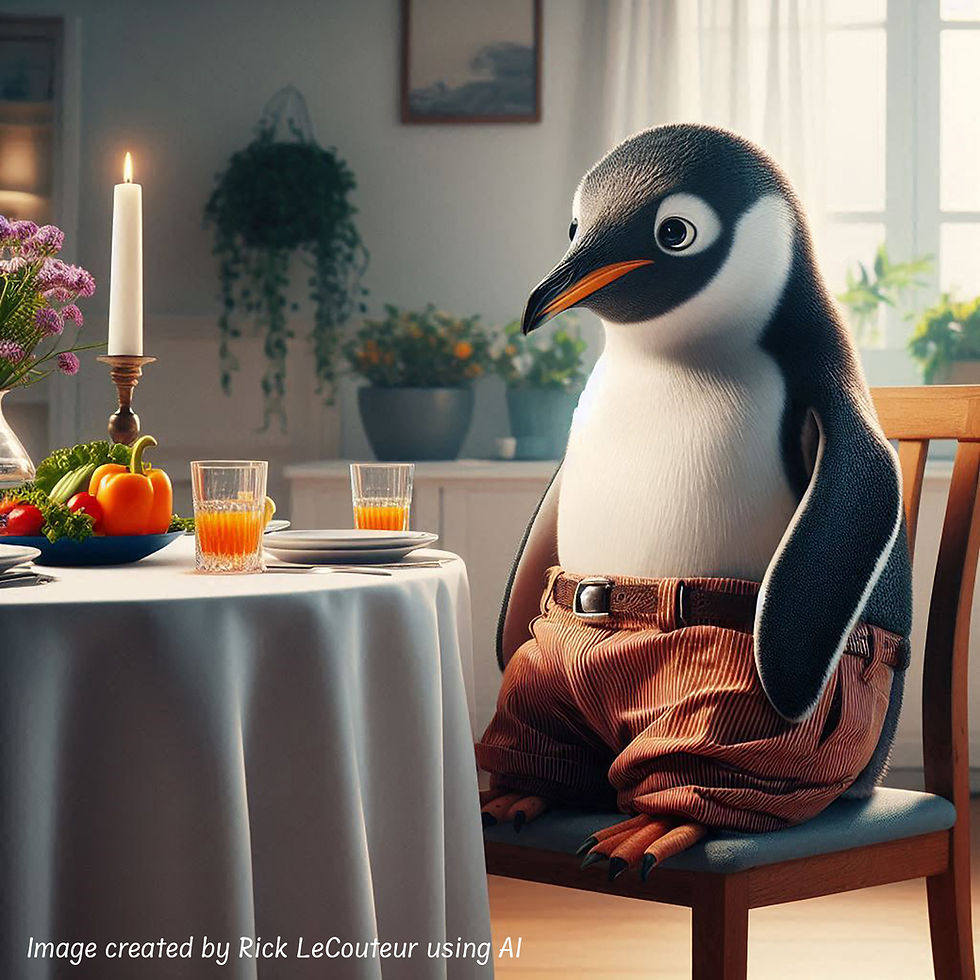When Animals Wear Pants: Anthropomorphism and learning (#4)
- RIck LeCouteur

- Jul 25, 2024
- 4 min read
Updated: Feb 23

Have you ever assigned personalities to your pets and explained their behaviors in terms of human motivations, such as imagining that a cat is being stubborn?
The attribution of human characteristics, behaviors, or emotions to non-human entities is called anthropomorphism. It often appears in various forms of media, such as talking animals in children’s literature or animated movies, fables and fairy tales where animals exhibit human-like qualities and engage in moral dilemmas.
Does this practice of unrealistic portrayal affect young children's early understanding of biology in relation to the natural world?
Anthropomorphism may contribute to a human-centered perspective on the natural world and encourage the belief that real animals possess human-specific traits, and it may interfere with children’s learning about real animals.
Should we continue to employ anthropomorphism to engage children in factual and biological learning about the natural world?
Early experiences and social learning can shape anthropocentric reasoning patterns. It has been observed that 3-year-old urban children do not display anthropocentric reasoning, suggesting that anthropocentrism is not an inherent, early developing foundation for biological knowledge. Instead, it appears to be acquired uniquely by urban children due to their limited experiences with animals.
Children who grow up in cultures that offer more opportunities for early exposure to nature and animals tend to exhibit less anthropocentric reasoning compared to urban children. Even within a single culture, the level of direct exposure to animals can vary among children, leading to differences in anthropocentric reasoning. Three-year-old children who have pets are less likely to exhibit anthropocentric reasoning compared to their peers without pets, presumably because they have more opportunities to observe and learn about real animals.
Children whose parents have expertise in biology-related fields, such as doctors, scientists, and veterinarians, tend to engage in more discussions about biological properties with their children. These children are also less prone to anthropocentric reasoning. Thus, both cultural factors and specific experiences, such as interactions with animals and exposure to nature, contribute to the development of conceptual understanding about animals in children.
Picture books are important educational tools during early development, as even infants as young as 15 months old can learn words and acquire general knowledge from them. A significant portion of children's media, including picture books, tends to depict animals in ways that are specific to human behavior.
In an analysis of over 1,000 children's picture books, nearly half of them featured animals, but only a quarter of those books situated the animals in natural environments. Even when animals were portrayed in natural settings, they often exhibited human-specific behavioral traits, such as talking, living in houses, or attending school.
Does anthropomorphism in picture books influence children's understanding of the natural world?
Some studies suggest that anthropomorphism can influence children's reasoning in both anthropocentric (human-centered) and anthropomorphic (attributing human traits) ways. In one study, 5-year-old children who read a realistic animal storybook were more likely to engage in biological reasoning when presented with a biological task. By contrast, children who read an anthropomorphic storybook were more inclined to reason anthropocentrically, focusing on human-like behaviors and characteristics.
Another study showed that 4- and 5-year-olds who were exposed to anthropomorphic facts about an unfamiliar animal, such as talking, taking baths, and having friends, were more likely to extend those anthropomorphic traits to real animals of the same kind, compared to children who read a realistic story about the animal.
However, the negative effects of anthropomorphism on learning may be limited to highly anthropomorphic depictions. In a study involving 3- to 5-year-olds, only when anthropomorphic pictures were combined with anthropomorphic language did children's factual learning decrease. However, when the language was manipulated, children learned equally well from both anthropomorphic and realistic storybooks. For example, children were able to accurately remember the stories when anthropomorphic pictures were combined with factual language. Thus, when more subtle forms of anthropomorphism are used, such as variations in language or illustrations, children can learn about animals just as effectively as they would from realistic media.
The impact of anthropomorphism on reasoning and learning can vary depending on the age of the child. In one study, 5- to 7-year-olds were found to be more likely than 8- to 12-year-olds to use and endorse anthropomorphic explanations for evolution after being exposed to anthropomorphic stories. This indicates that younger children may be more prone to adopting anthropomorphic thinking when presented with anthropomorphic materials.
However, research with high school students yielded different results. Anthropomorphic biology materials did not increase the students' use of anthropomorphic explanations, and the students reported being more engaged with the anthropomorphic material and felt that it improved their understanding. Whereas high school students typically use anthropomorphic and animistic explanations for scientific phenomena (e.g., “fluorine's being greedy trying to grab two electrons”), they recognize that their use of anthropomorphic descriptions is metaphorical rather than literal. Therefore, although anthropomorphism may interfere with factual learning and promote anthropomorphic thinking, especially among younger children, it may be beneficial for supporting the learning of older children and high school students.
Whether anthropomorphism is appropriate for engaging children in early science learning is an important question not just for developmental psychologists but also for educators, parents, and creators of children's media. Determining the efficacy of anthropomorphism in supporting children's factual and biological learning goes hand in hand with considering the cultural context and learning goals, the type and degree of social representation of animals being used, and the age of the child. Continued experimental work will help provide further insights into when and how anthropomorphism can be used to support early learning and biological reasoning.
#BunyipsBooks&Beyond



Comentários